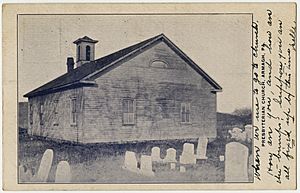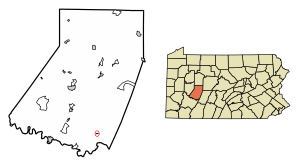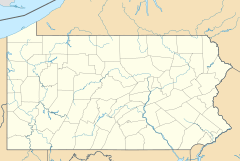Armagh, Pennsylvania facts for kids
Quick facts for kids
Armagh, Pennsylvania
|
|
|---|---|
|
Borough
|
|

The old Armagh Presbyterian Church was destroyed in 2004, but the cemetery remains along Route 56
|
|

Location of Armagh in Indiana County, Pennsylvania.
|
|
| Country | United States |
| State | Pennsylvania |
| County | Indiana |
| Settled | 1792 |
| Incorporated | 1824 |
| Government | |
| • Type | Borough Council |
| Area | |
| • Total | 0.06 sq mi (0.15 km2) |
| • Land | 0.06 sq mi (0.15 km2) |
| • Water | 0.00 sq mi (0.00 km2) |
| Population
(2020)
|
|
| • Total | 102 |
| • Density | 1,789.47/sq mi (686.19/km2) |
| Time zone | UTC-5 (Eastern (EST)) |
| • Summer (DST) | UTC-4 (EDT) |
| Zip code |
15920
|
| FIPS code | 42-03032 |
Armagh is a small town, called a borough, located in Indiana County, Pennsylvania, in the United States. In 2020, about 103 people lived there.
History of Armagh
Armagh is the oldest community in Indiana County. It was started in 1792 by eight families. These families were led by James and Margaret Jane Graham, and they came from Northern Ireland. The town was named after the city and county of Armagh in Ireland. This was where some of the first settlers came from.
The first school in Armagh opened in 1799. It was in a simple log cabin. In 1805, Armagh also got the first post office in the county.
Many of the first settlers were Presbyterian, a type of Christian faith. The Wheatfield Presbyterian Church, later known as Armagh Presbyterian Church, began in 1786. Its first minister, Rev. George Hill, started in 1792. He also served churches in nearby Fairfield and Donegal. In 1820, the church built a log building. Then, in 1835–1836, they built a new white wooden church. Another Presbyterian church was built in 1905 in Seward, about three miles south. The two churches joined together in 1963. Sadly, the Armagh church building was destroyed in 2004 when a truck hit it.
Armagh officially became a borough on April 10, 1824. Before that, it was part of East Wheatfield Township. A famous American labor leader named William H. Sylvis was born in Armagh in 1828. He worked to improve conditions for workers.
In 1940, a guide about Pennsylvania described Armagh. It said the town was settled by Irish immigrants in 1792. They found the hillside mostly empty except for a few small oak trees. This is why it was named Armagh. The guide also mentioned that in the days of stagecoaches, Armagh was a very busy place.
Geography of Armagh
Armagh is located at 40°27′13″N 79°1′50″W / 40.45361°N 79.03056°W. This means it's in a specific spot on the map.
The United States Census Bureau says that Armagh covers a total area of about 0.1 square miles (0.15 square kilometers). All of this area is land, with no water.
Population of Armagh
| Historical population | |||
|---|---|---|---|
| Census | Pop. | %± | |
| 1850 | 152 | — | |
| 1860 | 190 | 25.0% | |
| 1870 | 177 | −6.8% | |
| 1880 | 123 | −30.5% | |
| 1890 | 162 | 31.7% | |
| 1900 | 131 | −19.1% | |
| 1910 | 82 | −37.4% | |
| 1920 | 110 | 34.1% | |
| 1930 | 123 | 11.8% | |
| 1940 | 163 | 32.5% | |
| 1950 | 176 | 8.0% | |
| 1960 | 192 | 9.1% | |
| 1970 | 165 | −14.1% | |
| 1980 | 133 | −19.4% | |
| 1990 | 104 | −21.8% | |
| 2000 | 131 | 26.0% | |
| 2010 | 122 | −6.9% | |
| 2020 | 103 | −15.6% | |
| 2021 (est.) | 103 | −15.6% | |
| Sources: | |||
As of the 2000 census, there were 131 people living in Armagh. There were 54 households, which are groups of people living together, and 40 families. The population density was about 2,302 people per square mile. All the people living in the borough were White.
The population was spread out by age. About 18% of the people were under 18 years old. About 20% were 65 years or older. The average age in Armagh was 42 years old.
See also
 In Spanish: Armagh (Pensilvania) para niños
In Spanish: Armagh (Pensilvania) para niños



